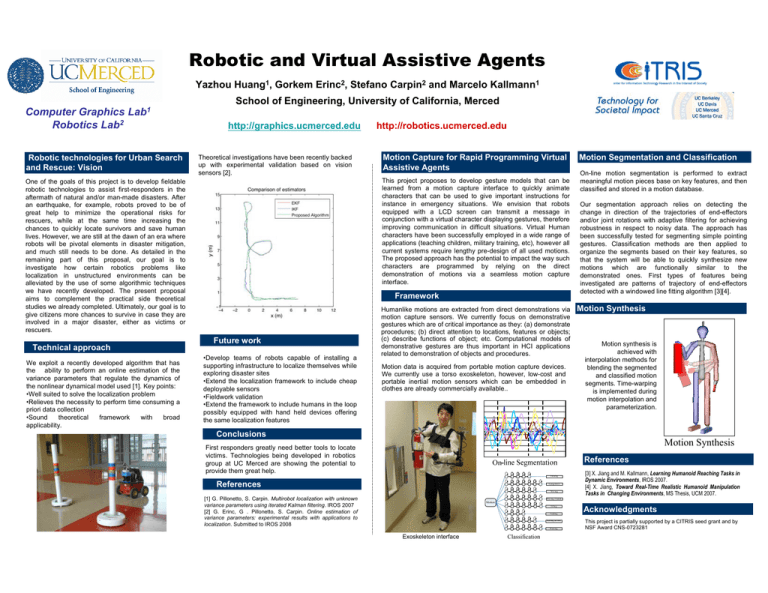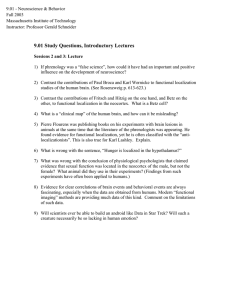Robotic and Virtual Assistive Agents
advertisement

Robotic and Virtual Assistive Agents Yazhou Huang1, Gorkem Erinc2, Stefano Carpin2 and Marcelo Kallmann1 School of Engineering, University of California, Merced Computer Graphics Lab1 Robotics Lab2 Robotic technologies for Urban Search and Rescue: Vision http://graphics.ucmerced.edu Theoretical investigations have been recently backed up with experimental validation based on vision sensors [2]. We exploit a recently developed algorithm that has the ability to perform an online estimation of the variance parameters that regulate the dynamics of the nonlinear dynamical model used [1]. Key points: •Well suited to solve the localization problem •Relieves the necessity to perform time consuming a priori data collection •Sound theoretical framework with broad applicability. Motion Capture for Rapid Programming Virtual Assistive Agents This project proposes to develop gesture models that can be learned from a motion capture interface to quickly animate characters that can be used to give important instructions for instance in emergency situations. We envision that robots equipped with a LCD screen can transmit a message in conjunction with a virtual character displaying gestures, therefore improving communication in difficult situations. Virtual Human characters have been successfully employed in a wide range of applications (teaching children, military training, etc), however all current systems require lengthy pre-design of all used motions. The proposed approach has the potential to impact the way such characters are programmed by relying on the direct demonstration of motions via a seamless motion capture interface. One of the goals of this project is to develop fieldable robotic technologies to assist first-responders in the aftermath of natural and/or man-made disasters. After an earthquake, for example, robots proved to be of great help to minimize the operational risks for rescuers, while at the same time increasing the chances to quickly locate survivors and save human lives. However, we are still at the dawn of an era where robots will be pivotal elements in disaster mitigation, and much still needs to be done. As detailed in the remaining part of this proposal, our goal is to investigate how certain robotics problems like localization in unstructured environments can be alleviated by the use of some algorithmic techniques we have recently developed. The present proposal aims to complement the practical side theoretical studies we already completed. Ultimately, our goal is to give citizens more chances to survive in case they are involved in a major disaster, either as victims or rescuers. Technical approach http://robotics.ucmerced.edu Framework Future work •Develop teams of robots capable of installing a supporting infrastructure to localize themselves while exploring disaster sites •Extend the localization framework to include cheap deployable sensors •Fieldwork validation •Extend the framework to include humans in the loop possibly equipped with hand held devices offering the same localization features Humanlike motions are extracted from direct demonstrations via motion capture sensors. We currently focus on demonstrative gestures which are of critical importance as they: (a) demonstrate procedures; (b) direct attention to locations, features or objects; (c) describe functions of object; etc. Computational models of demonstrative gestures are thus important in HCI applications related to demonstration of objects and procedures. Motion data is acquired from portable motion capture devices. We currently use a torso exoskeleton, however, low-cost and portable inertial motion sensors which can be embedded in clothes are already commercially available.. Motion Segmentation and Classification On-line motion segmentation is performed to extract meaningful motion pieces base on key features, and then classified and stored in a motion database. Our segmentation approach relies on detecting the change in direction of the trajectories of end-effectors and/or joint rotations with adaptive filtering for achieving robustness in respect to noisy data. The approach has been successfully tested for segmenting simple pointing gestures. Classification methods are then applied to organize the segments based on their key features, so that the system will be able to quickly synthesize new motions which are functionally similar to the demonstrated ones. First types of features being investigated are patterns of trajectory of end-effectors detected with a windowed line fitting algorithm [3][4]. Motion Synthesis Motion synthesis is achieved with interpolation methods for blending the segmented and classified motion segments. Time-warping is implemented during motion interpolation and parameterization. Conclusions Motion Synthesis First responders greatly need better tools to locate victims. Technologies being developed in robotics group at UC Merced are showing the potential to provide them great help. References Pointing References Lying down Waving [1] G. Pillonetto, S. Carpin. Multirobot localization with unknown variance parameters using iterated Kalman filtering. IROS 2007 [2] G. Erinc, G . Pillonetto, S. Carpin. Online estimation of variance parameters: experimental results with applications to localization. Submitted to IROS 2008 [3] X. Jiang and M. Kallmann, Learning Humanoid Reaching Tasks in Dynamic Environments, IROS 2007. [4] X. Jiang, Toward Real-Time Realistic Humanoid Manipulation Tasks in Changing Environments, MS Thesis, UCM 2007. Waving 2 hands Motion Sitting Nodding Raising an arm Running Exoskeleton interface Classification Acknowledgments This project is partially supported by a CITRIS seed grant and by NSF Award CNS-0723281




